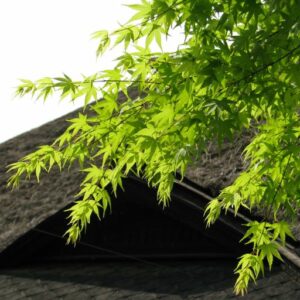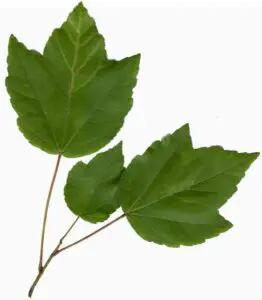Can any maple tree be a bonsai?

Any maple tree that fits certain desirable bonsai features such as having tiny leaves and growing small can be a bonsai. Having leaves with beautiful color and interesting shape are also an important appeal as a maple bonsai.
Maple tree facts
Maples are a diverse and versatile group of trees and shrubs, with around 190 varieties known today. With a center of diversity in China, maples range across the northern hemisphere from North America to Japan including much of Europe and Central/East Asia. Although it is primarily a temperate group, a few maples grow into the tropics as well.
This wide range of habitats and broad geographical distribution has resulted in a diverse group from huge trees to small shrubs. Leaf shape and size also vary greatly and range from simple 3–lobed leaves to more complex shapes with more than a dozen lobes, or compound leaves with 5–7 leaflets. Although maples are famous for their autumn color, some are actually evergreen.
Desirable characteristics of maple bonsai
As maple bonsai, it needs;
- To grow small,
- Dense foliage with small, light, delicate leaves, and
- Beautiful leaf color, preferably changing from green to yellow/red or vice versa.
In addition, a maple bonsai needs a round and smooth trunk, good ramification with fine, horizontal branches, and beautiful surface roots (nebari).
Tree and leaf sizes can artificially be dwarfed by bonsai techniques such as wiring and defoliation as well as confining roots into a shallow, small pot. But it can only go so far. An adult palm-size maple leaf can hardly be made into a baby-size leaf without expertise and long experience as bonsai enthusiasts.
If you are interested in how bonsai trees stay small, please read the following post.
It is true that some of the maple varieties which were commonly used as bonsai a few decades ago such as snake bark maple (Acer rufinerve) and lime-leaved maple (Acer distylum) have leaves as large as 6 inches (15cm).
But their popularity faded away partly because of the difficulty of making it a good bonsai. A bonsai tree has to look like a big, old tree grown on the ground. If leaves are disproportionately large compared to the width of the trunk and the height of the tree, this maple bonsai does not look “natural”; just a tree put in a pot.
Which maples are commonly used for bonsai?
There are 3 major species of maples used for bonsai today.
- Japanese maple (Acer palmatum/Acer amoenum/Acer palmatum subsp. matsumurae (Koidz) Ogata)
- Japanese red maple (Acer pycnanthum)
- Trident maple (Acer buergerianum)
Can red maple be a bonsai?

Red maple
Red maple (Acer rubrum) makes an excellent bonsai, thanks to its relatively small leaf size and beautiful autumn leaf as well as smooth bark especially when it is young. It has a high tolerance to heat, cold, drought and flood.
Red maple (Acer rubrum) is one of the most common and widespread deciduous trees of eastern and central North America. It grows in a very wide range of conditions; from swamps to poor dry soils, from Maine to Florida and from sea level to about 3000 ft (900m).
At maturity, it often attains a height of around 100 feet (30m) with the trunk diameter from 18 to 35 inches (46-88 cm). The leaves are typically 2-4 inches (5-10 cm) long and wide with 3-5 palmate lobes with a serrated margin. The bark is a pale grey and smooth when the individual is young. As the tree grows the bark becomes darker and cracks into slightly raised long plates.
Red maple (Acer rubrum) vs. Japanese maple (Acer palmatum)
| Red maple (Acer rubrum) |
Japanese maple (Acer palmatum) |
|
| Height | 100 ft (30m) | 50 ft (15m) |
| Trunk | 18 to 35 inches (46-88 cm) | 31 inches (80cm) |
| Leaf size | 2-4 inches (5-10 cm) | 1-2 inches (3-7cm) |
| Leaf shape | 3-5 palmate lobes | 5-7 palmate lobes |
| Leaf color | Green to red | Various |
| Bark | Smooth to rough | Smooth |
Can you bonsai a Canadian maple?

Canadian maple
(Source: Wikipedia)
Canadian maple (Acer saccharum) can be made into a bonsai to enjoy its beautiful autumn leaves, with a drawback of rather large leaf size.
Canadian maple (Acer saccharum), also known as the sugar maple, is native to eastern and central North America. It is commonly found in dry forests and woodlands but some subspecies do grow well in North Carolina and Florida.
Canadian maple may reach 50 to 120 feet tall with a trunk diameter of 30 to 60 inches. The leaves are 3-6 inches in length and width and have 5 lobes and coarsely toothed edges, which turn brilliant shades of red, orange or yellow in fall.
Canadian sugar maple grows best in moist, well-drained, slightly acidic, fertile soil in full sun but will tolerate average well-drained soils in sun to part shade. As it is intolerant of high heat and/or without direct sunlight, it cannot be an indoor bonsai.
Canadian maple (Acer saccharum) vs. Japanese maple (Acer palmatum)
| Canadian maple (Acer saccharum) |
Japanese maple (Acer palmatum) |
|
| Height | 40-120 ft (12-36m) | 50 ft (15m) |
| Trunk | 30 to 60 inches (80-160 cm) | 31 inches (80cm) |
| Leaf size | 3-6 inches (8-16cm) | 1-2 inches (3-7cm) |
| Leaf shape | 3-5 palmate lobes | 5-7 palmate lobes |
| Leaf color | Green to red | Various |
| Bark | Scaly and rough | Smooth |
Can you bonsai a bigleaf maple?

Bigleaf maple
Bigleaf maple (Acer macrophyllum) cannot make a good bonsai. It has the largest leaves of any maple, typically 6-12 inches (15-30 cm) across which make it very difficult to make a proportionate size for a bonsai tree.
Bigleaf maple is native to western North America from southernmost Alaska to southern California. True to its name, its leaves measure up to 12 inches (30cm) wide and almost as long, a singular feature that distinguishes the bigleaf maple from others.
Even with bonsai techniques to make the tree smaller, a huge leaf as bigleaf maple will be disproportionately large as a bonsai tree.
Can a Japanese maple be used for a bonsai?

Japanese maple
Japanese maple (Acer palmatum) can be used for bonsai. In fact, Japanese maple is one of the best species to make an outstanding bonsai. It is very well known as a bonsai species with small, light and delicate leaves that usually turn to beautiful red color in fall. It has a round trunk, smooth bark, and powerful surface roots, which are desirable features of a bonsai tree.
There are around 50 cultivars of the Japanese maple family with a variety of leaf color and shape. Some of the well-known cultivars include Kiyohime, Kotohime, Deshojo, Seigen and Shishigarhira.
To know more about Japanese maple, please read the following post.
—–
Reference
National Park Service (Link here)
North Carolina State University (Link here)
“The red list of maples” (Link here)



